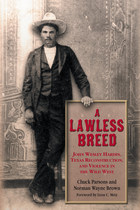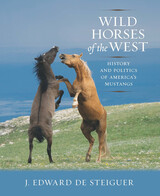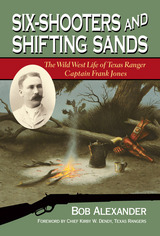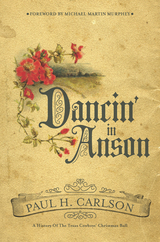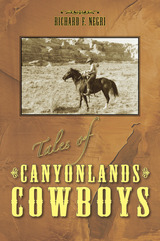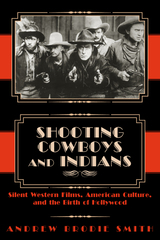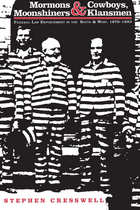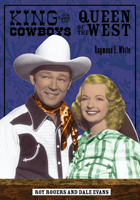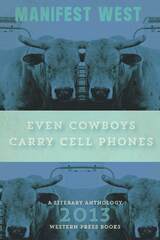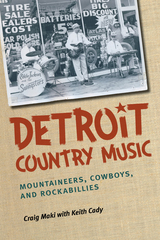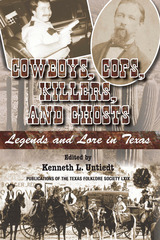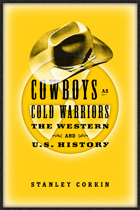CowboysCollection by Cassandra Verhaegen (12 items)Wrangle yourself some Wild West learning. Includes the following tags:
Actors, Alexander, Bob, American Culture, Anthologies (multiple authors), Birth, Christmas, Country & Bluegrass, Cowboys, Fiction, Frontier and pioneer life, Indians, Mammals, Mexican-American Border Region, Milbrodt, Teresa, Mormons, Reconstruction (U.S. history, 1865-1877), Regional Studies, Shifting Sands, Texas, Texas Rangers. Frontier Battalion. Company D, Western, Western films
See More
|
A Lawless Breed
by Chuck Parsons and Norman Wayne Brown
University of North Texas Press, 2013
1
|
Wild Horses of the West
by J. Edward de Steiguer
University of Arizona Press, 2011
When the Spanish explorers brought horses to North America, the horses were, in a sense, returning home. Beginning with their origins fifty million years ago, the wild horse has been traced from North America through Asia to the plains of Spain’s Andalusia and then back across the Atlantic to the ranges of the American West. When given the chance, these horses simply took up residence in the landscape that their ancestors had roamed so long ago.
In Wild Horses of the West, J. Edward de Steiguer provides an entertaining and well-researched look at one of the most controversial animal welfare issues of our time—the protection of free-roaming horses on the West’s public lands. This is the first book in decades to include the entire story of these magnificent animals, from their evolution and biology to their historical integration into conquistador, Native American, and cowboy cultures. And the story isn’t over. De Steiguer goes on to address the modern issues— ecology, conservation, and land management—surrounding wild horses in the West today. Featuring stunning color photographs of wild horses, this extremely thorough and engaging blend of history, science, and politics will appeal to students of the American West, conservation activists, and anyone interested in the beauty and power of these striking animals.
2
|
Dancin' in Anson
by Paul H. Carlson
foreword by Michael Martin murphey Texas Tech University Press, 2014
Celebrating the celebration of the Old West
In the 1880s, there wasn't much in Anson, Texas, in the way of entertainment for the area’s cowhands. But Star Hotel operator M. G. Rhodes changed that when he hosted a Grand Ball the weekend before Christmas. A restless traveling salesman, rancher, and poet from New York named William Lawrence Chittenden, a guest at the Star Hotel, was so impressed with the soiree that he penned his observances in the poem “The Cowboys’ Christmas Ball.” Reenacted annually since 1934 based on Chittenden’s poem, the contemporary dances attract people from coast to coast, from Canada, and from across Europe and elsewhere. Since 1993 Grammy Award-winning musical artist Michael Martin Murphey has played at the popular event. Far more than a history of the Jones County dance, Paul Carlson analyzes the long poem, defining the many people and events mentioned and explaining the Jones County landscape Chittenden lays out in his celebrated work. The book covers the evolution of cowboy poetry and places Chittenden and his poem chronologically within the ever-changing western genre. Dancin’ in Anson: A History of the Texas Cowboys' Christmas Ball is a novel but refreshing look at a cowboy poet, his poem, and a joyous Christmas-time family event that traces its roots back nearly 130 years.
4
|
Tales of Canyonlands Cowboys
by Richard Negri
Utah State University Press, 1997
Richard Negri interviews cattlemen and women about ranching in the rugged canyonlands region of southeastern Utah. Personal stories and anecdotes from the colorful characters who ground out a hard living on ranches of the are in the early twentieth century.
5
|
Shooting Cowboys and Indians
by Andrew Brodie Smith
University Press of Colorado, 2003
Academics have generally dismissed Hollywood's cowboy and Indian movies - one of its defining successful genres - as specious, one-dimensional, and crassly commercial. In Shooting Cowboys and Indians, Andrew Brodie Smith challenges this simplistic characterization of the genre, illustrating the complex and sometimes contentious process by which business interests commercialized images of the West.
Tracing the western from its hazy silent-picture origins in the 1890s to the advent of talking pictures in the 1920s, Smith examines the ways in which silent westerns contributed to the overall development of the film industry. Focusing on such early important production companies as Selig Polyscope, New York Motion Picture, and Essanay, Smith revises current thinking about the birth of Hollywood and the establishment of Los Angeles as the nexus of filmmaking in the United States. Smith also reveals the role silent westerns played in the creation of the white male screen hero that dominated American popular culture in the twentieth century. Illustrated with dozens of historic photos and movie stills, this engaging and substantive story will appeal to scholars interested in Western history, film history, and film studies as well as general readers hoping to learn more about this little-known chapter in popular filmmaking.
6
|
Mormons and Cowboys, Moonshiners and Klansman
by Stephen Cresswell
University of Alabama Press, 1991
In the decades immediately following the Civil War, the United States expanded rapidly. As the nation grew, so too did federal law, moving into areas of citizens’ lives previously regulated by local custom and state and territorial statutes. In Mormons and Cowboys, Moonshiners and Klansmen, Cresswell uses then moves beyond a case-study approach to illuminate larger questions including the evolution of the American criminal justice system, the relationship of the South and the West to the rest of the nation, the workings of the 19th-century American bureaucracy, and conflict of the local, state, and federal governments. Out of the efforts of early federal marshals came the modern federal justice system, with its firm policy guidelines, its Federal Bureau of Investigation, and its broader powers over the country as a whole.
7
|
King of the Cowboys, Queen of the West
by Raymond E. White
University of Wisconsin Press, 2006
For more than sixty years, Roy Rogers and Dale Evans personified the romantic, mythic West that America cherished well into the modern age. Blazing a trail through every branch of the entertainment industry—radio, film, recordings, television, and even comic books—the couple capitalized on their attractive personas and appealed to the nation's belief in family values, an independent spirit, community.
See More
King of the Cowboys, Queen of the West presents these two celebrities in the most comprehensive and inclusive account to date. Part narrative, part reference, this impeccably researched, highly accessible survey spans the entire scope of Rogers's and Evans's careers, illuminating and celebrating their place in twentieth-century American popular culture. Following the pair through each stage of their professional and personal trajectories, author Raymond E. White explores the unique alchemy of the singing cowboy and his free-spirited yet feminine partner. In a dual biography, he shows how Rogers and Evans carefully husbanded their public image and—of particular note—incorporated their Christian faith into their performances. And in a series of exhaustive appendixes, he documents their contributions to each medium they worked in. Testifying to both the breadth and the longevity of their careers, the book includes radio logs, discographies, filmographies, and comicographies that will delight historians and collectors alike. With its engaging tone and meticulous research, King of the Cowboys, Queen of the West is bound to become the definitive source on the lives of these two great American icons.
8
|
Even Cowboys Carry Cell Phones
edited by Teresa Milbrodt
University Press of Colorado, 2013
Like any legendary figure, the cowboy is part myth and part reality, memorialized by history and Hollywood, envied by those who spend days at desks and dream of trading swivel chairs for saddles. The writings in this anthology serve as testament to the cultural love, bordering on obsession, of the American cowboy. These works cover the gamut, from the romanticized movie cowboy to ranchers, freelancers, and contemporary wranglers who wear hoodies and work in massive feedlot pens.
The cowboy that emerges from this collection is multifaceted, as the book juxtaposes cowboys spraying longhorns at a car wash to cowboys advertising services on Craigslist and Pepsi-drinking cowboys riding Amtrak trains. There are portraits of the old cowboys, crotchety coffee-swigging men with too many stories about how things were better four decades ago. However, the figure remains one constructed of loyalties—loyalty to work, loyalty to family, loyalty to animals, loyalty to the land. The image of the cowboy is vivid in our imagination, insperable from Western mythology, a means to connect ourselves with the wild and rugged individuals we dream we used to be. In this age of computers and cubicles we want to touch and preserve that history, but we must allow for shifting traditions. As the thirty-five authors in this collection will remind you, even cowboys carry cell phones.
9
|
Detroit Country Music
by Craig Maki and Keith Cady
University of Michigan Press, 2013
The richness of Detroit’s music history has by now been well established. We know all about Motown, the MC5, and Iggy and the Stooges. We also know about the important part the Motor City has played in the history of jazz. But there are stories about the music of Detroit that remain untold. One of the lesser known but nonetheless fascinating histories is contained within Detroit’s country music roots. At last, Craig Maki and Keith Cady bring to light Detroit’s most important country and western and bluegrass stars, such as Chief Redbird, the York Brothers, and Roy Hall. Beyond the individuals, Maki and Cady also map out the labels, radio programs, and performance venues that sustained Detroit’s vibrant country and bluegrass music scene. In the process, Detroit Country Music examines how and why the city’s growth in the early twentieth century, particularly the southern migration tied to the auto industry, led to this vibrant roots music scene. This is the first book—the first resource of any kind—to tell the story of Detroit’s contributions to country music. Craig Maki and Keith Cady have spent two decades collecting music and images, and visiting veteran musicians to amass more than seventy interviews about country music in Detroit. Just as astounding as the book’s revelations are the photographs, most of which have never been published before. Detroit Country Music will be essential reading for music historians, record collectors, roots music fans, and Detroit music aficionados.
10
|
Cowboys, Cops, Killers, and Ghosts
by Kenneth L. Untiedt
University of North Texas Press, 2013
11
|
Cowboys As Cold Warriors
by Stanley Corkin
Temple University Press, 2004
Though the United States emerged from World War II with superpower status and quickly entered a period of economic prosperity, the stresses and contradictions of the Cold War nevertheless cast a shadow over American life. The same period marked the heyday of the western film. Cowboys as Cold Warriors shows that this was no coincidence. It examines many of the significant westerns released between 1946 and 1962, analyzing how they responded to and influenced the cultural climate of the country. Author Stanley Corkin discusses a dozen films in detail, connecting them to each other and to numerous others. He considers how these cultural productions both embellished the myth of the American frontier and reflected the era in which they were made. Films discussed include: My Darling Clementine, Red River, Duel in the Sun, Pursued, Fort Apache, Broken Arrow, The Gunfighter, High Noon, Shane, The Searchers, Gunfight at the OK Corral, The Magnificent Seven, The Alamo, Lonely Are the Brave, Ride the High Country, and The Man Who Shot Liberty Valance.
12
|
|
| Click here to go to the beginning. | ||||||||||||
